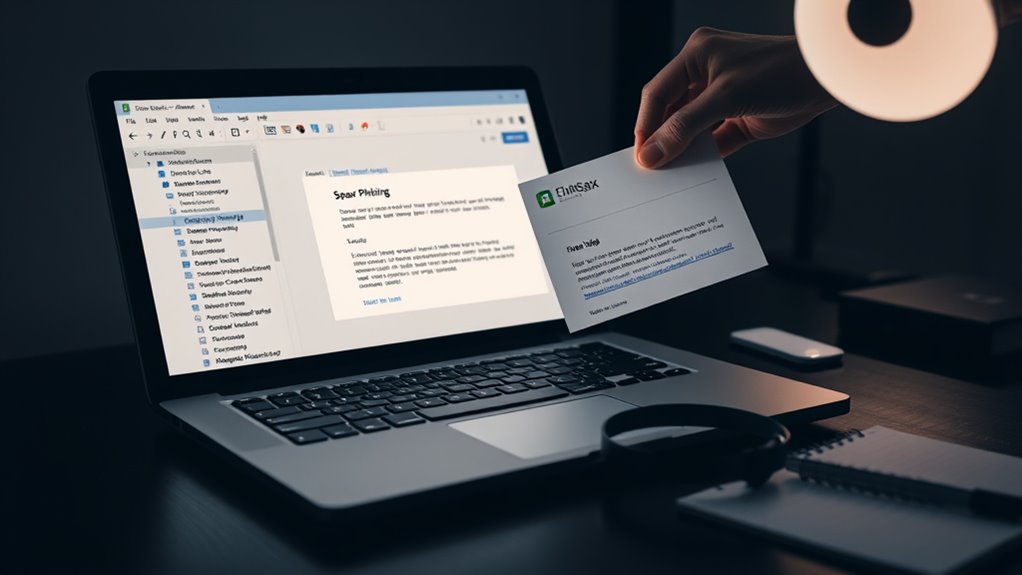Phishing targets many people with generic emails that seem trustworthy, hoping to trick you into sharing sensitive info. Spear phishing, however, is more targeted; attackers personalize messages based on research about you or your organization to make them more convincing. While phishing relies on mass appeal, spear phishing uses detailed tactics to increase success rates. To stay protected, understanding these differences helps you recognize suspicious messages—and if you want to learn how to spot them, keep exploring.
Key Takeaways
- Phishing targets a broad audience with generic emails, while spear phishing targets specific individuals with personalized messages.
- Phishing uses mass email campaigns, whereas spear phishing involves detailed research to craft convincing, targeted attacks.
- Spear phishing is more convincing and has a higher success rate due to personalization and tailored content.
- Both tactics rely on social engineering, but spear phishing exploits specific trust and relationships for greater impact.
- Defending against both requires vigilance, recognizing suspicious signs, and verifying sender identities before responding.

Phishing and spear phishing are deceptive tactics cybercriminals use to steal sensitive information, but they differ markedly in their approach and targets. With phishing, you’re usually dealing with mass email campaigns that aim to lure a broad audience into clicking malicious links or providing personal data. These emails often appear to come from reputable organizations, using email spoofing techniques to disguise the sender’s true identity. Email spoofing tricks your inbox into believing the message is legitimate, making it more likely you’ll fall for the scam. Attackers rely heavily on social engineering to craft convincing messages that evoke urgency, fear, or curiosity, prompting you to act without thinking. The goal is to exploit your trust and manipulate your emotional response, increasing the chances you’ll disclose confidential info or download malware. Both tactics often target human vulnerabilities rather than technical defenses, emphasizing the importance of vigilance.
Spear phishing, on the other hand, is much more targeted and personalized. Instead of casting a wide net, cybercriminals conduct research to gather details about you—your job, colleagues, interests, or recent activities. This information helps them craft emails that look like they’re from someone you know and trust, such as a coworker, boss, or business partner. Because these messages are tailored specifically to you, they’re considerably more convincing. The attacker’s social engineering skills shine here, as they manipulate your perception of familiarity and authority, making it easier to deceive you into revealing sensitive data or granting access to secure systems. Unlike broad phishing campaigns, spear phishing requires a lot of effort and planning, which is why it often results in more successful breaches. Incorporating knowledge about health benefits and related topics can help you stay alert to suspicious health-related messages that may be part of a scam.
Both tactics exploit human vulnerabilities, relying heavily on social engineering to bypass technical defenses. Email spoofing plays an essential role in both, as it allows cybercriminals to impersonate trusted sources convincingly. You need to be vigilant about scrutinizing unexpected emails, especially those urging immediate action or requesting confidential info. Look for signs like inconsistent sender addresses, generic greetings, or unexpected attachments. Recognizing the signs of social engineering can help you avoid falling victim. Remember, attackers often use emotional triggers to cloud your judgment, so taking a moment to verify the sender’s identity before responding can save you from serious consequences. Staying cautious and questioning suspicious messages is your best defense against both broad phishing scams and highly targeted spear phishing attacks.
Frequently Asked Questions
How Can Organizations Effectively Train Employees Against Spear Phishing?
To protect your organization from spear phishing, you should focus on security awareness and employee training. Teach staff to recognize suspicious emails, verify sender identities, and avoid sharing sensitive information. Conduct regular simulated attacks to reinforce these lessons and keep security top of mind. By fostering a culture of vigilance and providing ongoing education, you empower your employees to identify and prevent targeted threats effectively.
What Are the Latest Technological Tools to Detect Phishing Attempts?
You can stay ahead of phishing attempts by leveraging advanced tools like email authentication protocols, such as DMARC, SPF, and DKIM, which verify sender legitimacy. Additionally, threat intelligence platforms analyze emerging attack patterns, helping you spot potential threats early. These technologies work together to filter suspicious emails, protect your systems, and guarantee that you’re alert to the latest phishing tactics before they reach your inbox.
Can Phishing Attacks Target Mobile Devices Specifically?
Think of your mobile device as a castle’s gate, vulnerable to sneaky invaders. Yes, phishing attacks can target your mobile devices specifically, exploiting mobile vulnerabilities and weak app security. Cybercriminals craft convincing messages to trick you into revealing sensitive info or installing malicious apps. Protect yourself by staying cautious with links, updating your apps regularly, and using security tools to defend your mobile fortress from these digital invaders.
What Legal Consequences Exist for Cybercriminals Involved in Phishing?
You should know that cybercriminals involved in phishing can face serious legal consequences. Cybercrime statutes impose penalties like fines and imprisonment, which are enforced through penalty enforcement agencies. These laws aim to deter such activities and hold offenders accountable. If you’re targeted, understanding these consequences highlights the importance of cybersecurity measures to protect yourself and discourage cybercriminals from engaging in phishing schemes.
How Does Social Engineering Differ From Phishing Tactics?
You should understand that social engineering involves psychological manipulation to deceive you or others into revealing sensitive information. Unlike email impersonation, which is a specific tactic used in phishing, social engineering encompasses various methods, including phone calls or in-person tricks. Both aim to exploit trust, but social engineering is broader, focusing on manipulating human emotions and behavior rather than just technical email tricks.
Conclusion
Understanding the difference between phishing and spear phishing is like knowing the difference between a wild river and a targeted stream—you can navigate safely once you recognize the current. Stay vigilant, never click on suspicious links, and verify requests before acting. By staying alert, you’re the lighthouse guiding your personal information away from hidden rocks. Remember, in the sea of cyber threats, knowledge is your strongest anchor. Protect yourself before you become the next caught fish.









